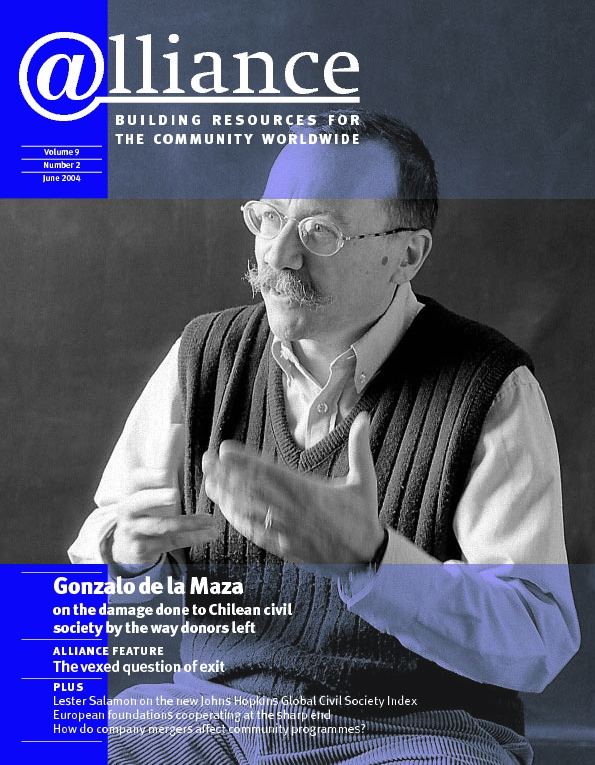The two-day meeting in Turin at the beginning of April was scheduled to be the last plenary meeting of what is now referred to as INSP1. In fact, the whole second day was devoted to discussion of what INSP2 might look like, and INSP1 is not now scheduled to end until mid-2005, allowing time for the various ‘products’ to be completed and disseminated.
The discussion of INSP2 might usefully have been preceded by some sort of assessment of what INSP1 has actually achieved – which didn’t happen. So what did INSP set out to do? According to the meeting notes, ‘INSP provides a forum for dialogue and critical thinking on the role of philanthropy and its impact on societies around the world.’ The most tangible achievement is a series of high-quality papers on a range of subjects of relevance to foundations[1] plus an internet-based theory of change development tool. Our first day in Turin was largely spent in breakout sessions giving feedback on the latest iterations of these ‘products’.
But INSP was not set up as INSP Publishing simply to produce papers – it would hardly have been a good way to achieve this. The aim, insisted INSP manager Dirk Eilinghoff, was to produce positive change, not publications. The collection of papers is simply a way of disseminating some of the knowledge that exists in the network. They have drawn heavily on network members for ideas and feedback – in the case of the paper on innovations in strategic philanthropy, on many outside the network as well.
Defining our terms?
One huge gap is a definition of strategic philanthropy. This gap was recognized some time ago, and last year’s Long Island plenary included four sessions to begin to map the concept. The idea was to produce an empirical definition, based on how people actually use the term. However, nothing is more hotly contested than definitions, and this process has a long way to go. Is strategic philanthropy something other than ‘good’ or ‘great’ or ‘effective’ philanthropy, people in Turin asked. Won’t any empirical definition be out of date in a few years’ time? Isn’t there a danger that an empirical definition will end up being treated as a normative one?
I hope that INSP will complete this work – the fact that it’s difficult surely doesn’t mean that it’s not worth doing. One fruitful approach might be to press on with the empirical mapping and to complement this with some qualitative research, looking at different ways people might apply the term in practice. Luc Tayart de Borms’ (King Baudouin Foundation, Belgium) presentation of what he calls ‘the impact-driven foundation’[2] provided one fascinating interpretation of ‘strategic philanthropy’.
What about INSP2?
Meeting participants were divided into four groups and asked to consider the challenges facing philanthropy and how an extended INSP could respond to them. Not surprisingly, all groups identified a huge range of challenges facing the field, and a wide range of roles a network like INSP could play. Many of these came into the category of increasing the availability of high-quality information to the field. The sharing of information on successes and failures, including evaluations, was seen as something that could possibly happen within the safe space of a closed network – a start at least! Most people clearly felt that the network was valuable and should be continued if possible – though including more people from non-OECD countries was seen as vital.
My group focused on what can and can’t be expected from a network. In INSP1, network members had mostly engaged in writing papers themselves, but this was clearly a one-off for people with demanding ‘day jobs’. In future ‘responsive content’ would need to be purchased (from researchers, consultants, etc), with the network providing the initial ideas, specific information, feedback/vetting, and so on. The network could be connected through a closed listserv, e-bulletins and scheduled online chat rooms. A global philanthropy website and regional meetings were also mentioned. Although all agreed that some sort of administrative secretariat would be needed, and therefore some funding, it was felt that the network should be more self-directed and leadership more decentralized. All groups envisaged a pilot period of 3-5 years, after which the network might become more or less self-sustaining. If by that stage people don’t feel it’s worth paying something for the benefit of belonging, there probably won’t be a future.
What next? The Bertelsmann team took away the various bits of paper the groups had worked on and will now produce a concrete proposal. ‘I refuse to say this is goodbye,’ said Eilinghoff.
1 These include philanthropy and globalization; vehicles for philanthropy; promoting philanthropy; accountability and transparency; evaluation; innovations from around the world; effective foundation boards; managing talent; stakeholder interaction; and knowledge management.
2 Such a foundation engages in a range of activities from charity and service delivery to social/policy change and convening, using both grantmaking and operating approaches, whichever is more effective for a particular activity.
For more information see http://www.insp.efc.be
If you have interesting and challenging texts on strategic approaches to philanthropy that you’d like to include on the INSP website, please contact Dirk Eilinghoff at dirk.eilinghoff@bertelsmann.de






Comments (0)